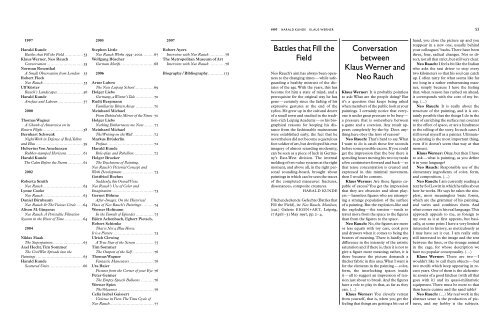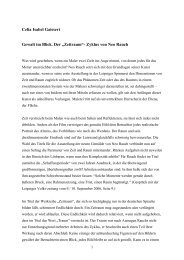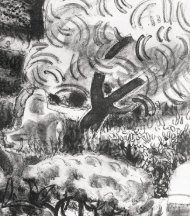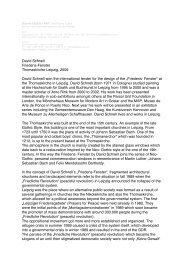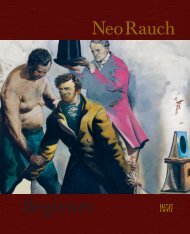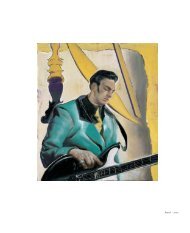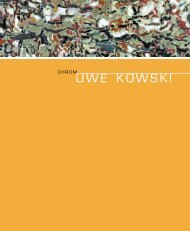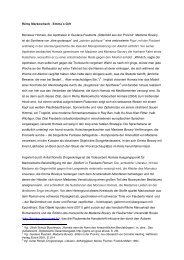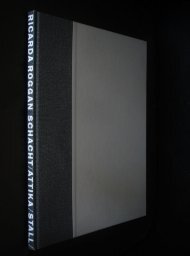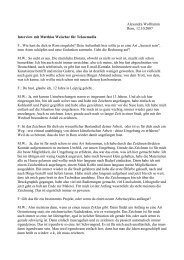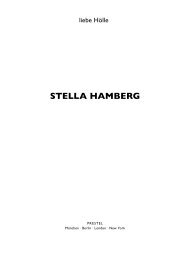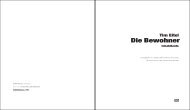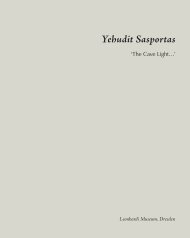Durch Rauch gesehen - Galerie EIGEN+ART
Durch Rauch gesehen - Galerie EIGEN+ART
Durch Rauch gesehen - Galerie EIGEN+ART
Sie wollen auch ein ePaper? Erhöhen Sie die Reichweite Ihrer Titel.
YUMPU macht aus Druck-PDFs automatisch weboptimierte ePaper, die Google liebt.
1997<br />
Harald Kunde<br />
. . . Battles . . . . . . . . . . that . . . . . Fill . . . . . the . . . . Field . . . . . . . . . . . . . . . . . . . . . . 53 .<br />
Klaus Werner, Neo <strong>Rauch</strong><br />
. . . Conversation<br />
. . . . . . . . . . . . . . . . . . . . . . . . . . . . . . . . . . . . . . . . . . . . . . 53 .<br />
Norman Rosenthal<br />
. . . A . . . Small . . . . . . . . Observation . . . . . . . . . . . . . . . . from . . . . . . Londonn . . . . . . . . . . . . . 55 .<br />
Robert Fleck<br />
. . . Neo . . . . . . <strong>Rauch</strong> . . . . . . . . . . . . . . . . . . . . . . . . . . . . . . . . . . . . . . . . 55 .<br />
Ulf Küster<br />
. . . <strong>Rauch</strong>’s . . . . . . . . . . . Landscapes<br />
. . . . . . . . . . . . . . . . . . . . . . . . . . . . . . . . . . . 56 .<br />
Harald Kunde<br />
. . . Artefact . . . . . . . . . . . and . . . . . Labour . . . . . . . . . . . . . . . . . . . . . . . . . . . . . . 57 .<br />
2000<br />
Thomas Wagner<br />
A Chunk of Antarctica on its<br />
. Return . . . . . . . . . Flight . . . . . . . . . . . . . . . . . . . . . . . . . . . . . . . . . . . . . . . 58<br />
Bernhart Schwenk<br />
Night Work in Defence of Red, Yellow<br />
. and . . . . . Blue . . . . . . . . . . . . . . . . . . . . . . . . . . . . . . . . . . . . . . . . . . . 59 .<br />
Hubertus Von Amelunxen<br />
. . . Rubber-stamped . . . . . . . . . . . . . . . . . . . . . Horizons . . . . . . . . . . . . . . . . . . . . . . . . . 61 .<br />
Harald Kunde<br />
. . . The . . . . . Calm . . . . . . . . Before . . . . . . . . the . . . . . Storm . . . . . . . . . . . . . . . . . . . . 61 .<br />
2002<br />
Roberta Smith<br />
Neo <strong>Rauch</strong><br />
Lynne Cooke<br />
Neo <strong>Rauch</strong><br />
Daniel Birnbaum<br />
Neo <strong>Rauch</strong> & The Vicious Circle<br />
Alison M. Gingeras<br />
Neo <strong>Rauch</strong>. A Peristaltic Filtration<br />
System in the River of Time<br />
. . . . . . . . . . . . . . . . . . . . . . . . . . . . . . . . . . . . . . . . . . . . . . . . .<br />
. . . . . . . . . . . . . . . . . . . . . . . . . . . . . . . . . . . . . . . . . . . . . . . . . .<br />
. . . . . . . . . . . . . . . . . . . . . . . . . . . . . . . . . . . . . . . . . . . . . . . . .<br />
. . . . . . . . . . . . . . . . . . . . . . . . . . . . . . . . . . . . . . . . . . . . . . . . . .<br />
2004<br />
Niklas Maak<br />
The Superpainter<br />
Axel Hecht, Tim Sommer<br />
The Civil War Spreads into the<br />
Paintings<br />
Harald Kunde<br />
Scattered Units<br />
. . . . . . . . . . . . . . . . . . . . . . . . . . . . . . . . . . . . . . . . . . . . . . . . . .<br />
. . . . . . . . . . . . . . . . . . . . . . . . . . . . . . . . . . . . . . . . . . . . . . . . . .<br />
. . . . . . . . . . . . . . . . . . . . . . . . . . . . . . . . . . . . . . . . . . . . . . . . . .<br />
63<br />
63<br />
64<br />
64<br />
65<br />
65<br />
66<br />
2005<br />
Stephen Little<br />
Neo <strong>Rauch</strong>.Works 1994–2002<br />
Wolfgang Büscher<br />
German Motifs<br />
. . . . . . . . . . . . . . . . . . . . . . . . . . . . . . . . . . . . . . . . . . . . . . . . .<br />
. . . . . . . . . . . . . . . . . . . . . . . . . . . . . . . . . . . . . . . . . . . . . . . . . .<br />
2006<br />
67<br />
68<br />
Artur Lubow<br />
. . . The . . . . . . New . . . . . . Leipzig . . . . . . . . . . School . . . . . . . . . . . . . . . . . . . . . . . 69 . .<br />
Holger Liebs<br />
. . . Germany, . . . . . . . . . . . . . a . . Winter’s . . . . . . . . . . . Tale . . . . . . . . . . . . . . . . . . . 70 .<br />
Rudij Bergmann<br />
. . . Familiarity . . . . . . . . . . . . . . . Blown . . . . . . . . Away . . . . . . . . . . . . . . . . . . . . . . 70 . .<br />
. Meinhard Michael<br />
From Behind the Mirror of the Times 70<br />
Holger Liebs<br />
. . . Nothing . . . . . . . . . . . Embarrasses . . . . . . . . . . . . . . . . me . . . . Now . . . . . . . . . . . . . . . 71 .<br />
Meinhard Michael<br />
. . . The . . . . . Writing . . . . . . . . . . . on . . . the . . . . Wall . . . . . . . . . . . . . . . . . . . . . . 72 . .<br />
Markus Brüderlin<br />
. . . Preface . . . . . . . . . . . . . . . . . . . . . . . . . . . . . . . . . . . . . . . . . . . . . 72 . .<br />
Harald Kunde<br />
. . . Role-play . . . . . . . . . . . . . and . . . . . Rebellion . . . . . . . . . . . . . . . . . . . . . . . . . . . 72 . .<br />
Holger Broeker<br />
The Touchstone of Painting.<br />
Neo <strong>Rauch</strong>’s Pictorial Concept and<br />
. Work . . . . . . . Development<br />
. . . . . . . . . . . . . . . . . . . . . . . . . . . . . . . . . . . . . . . . . 73 .<br />
Gottfried Boehm<br />
Suddenly, this Overall View.<br />
Neo <strong>Rauch</strong>’s Use of Color and<br />
. Imagination<br />
. . . . . . . . . . . . . . . . . . . . . . . . . . . . . . . . . . . . . . . . . . . . . . . . 73 .<br />
Gernot Böhme<br />
After-Images. On the Historical<br />
. Place . . . . . . . of . . . Neo . . . . . <strong>Rauch</strong>’s . . . . . . . . . . . Paintings . . . . . . . . . . . . . . . . . . . . . . 74 .<br />
Werner Hofmann<br />
. . . In . . . . the . . . . Tumult . . . . . . . . . . of . . Episodes . . . . . . . . . . . . . . . . . . . . . . . . . . 75 .<br />
Björn Achenbach, Egbert Pietsch,<br />
Robert Schimke<br />
That is Not a Blue Horse.<br />
. It . . is . . . a . . Picture . . . . . . . . . . . . . . . . . . . . . . . . . . . . . . . . . . . . . . . . . 75 .<br />
Ulrich Clewing<br />
. . . A . . . True . . . . . . Star . . . . . . . of . . the . . . . . Screen . . . . . . . . . . . . . . . . . . . . . . . 75 .<br />
Tim Sommer<br />
. . . The . . . . . . Outpost . . . . . . . . . . of . . . the . . . . . Self . . . . . . . . . . . . . . . . . . . . . . 76 .<br />
Thomas Wagner<br />
. . . Fantastic . . . . . . . . . . . . Maneuvers<br />
. . . . . . . . . . . . . . . . . . . . . . . . . . . . . . . . . . 76<br />
Uta Baier<br />
Pictures from the Corner of your Eye 76<br />
Peter Geimer<br />
. . . The . . . . . . Empty . . . . . . . . . Speech . . . . . . . . . Balloons . . . . . . . . . . . . . . . . . . . . . . 76 .<br />
Werner Spies<br />
. . . The . . . . . Volcanoes<br />
. . . . . . . . . . . . . . . . . . . . . . . . . . . . . . . . . . . . . . . . . 76 .<br />
Celia Isabel Gaissert<br />
Violence in View. The Time Cycle of<br />
. Neo . . . . . <strong>Rauch</strong> . . . . . . . . . . . . . . . . . . . . . . . . . . . . . . . . . . . . . . . . . . . 77 .<br />
. . . . . . . . . . . . . . . . . . . . . . . . . . . . . . . . . . . . . . . . . . . . . . . . . .<br />
. .<br />
2007<br />
Robert Ayers<br />
. . . Interview . . . . . . . . . . . . . with . . . . . . Neo . . . . . . <strong>Rauch</strong> . . . . . . . . . . . . . . . . . . . . . 78 .<br />
. The Metropolitan Museum of Art<br />
. . . Interview . . . . . . . . . . . . . with . . . . . . Neo . . . . . . <strong>Rauch</strong> . . . . . . . . . . . . . . . . . . . . . 78 .<br />
Biography / Bibliography<br />
113<br />
1997 HAR ALD KUNDE KLAUS WERNER<br />
Battles that Fill the<br />
Field<br />
Neo <strong>Rauch</strong>’s aim has always been openness<br />
to the changing times — while safeguarding<br />
a healthy mistrust of the dictates<br />
of the age. With the years, this has<br />
become for him a state of mind, and a<br />
prerequisite for the original way he has<br />
gone — certainly since the fading of his<br />
expressive gestures at the end of the<br />
1980s. He grew up in the cultural desert<br />
of a small town and studied in the tradition-rich<br />
Leipzig Academy — so his biographical<br />
reasons for keeping his distance<br />
from the fashionable mainstream<br />
were established early; the fact that he<br />
nevertheless did not become a querulous<br />
foot soldier of art, but developed his own<br />
imagery of almost retarding modernity,<br />
can be seen as a piece of luck in Germany’s<br />
East-West division. The internal<br />
melding of two value systems at the right<br />
moment, and above all, in the right personal<br />
sounding-board, brought about<br />
paintings in which can be seen the traces<br />
of the completed maneuver: fractures,<br />
dissonances, composite creatures.<br />
HARALD KUNDE<br />
Flächendeckende Gefechte (Battles that<br />
Fill the Field), in: Neo <strong>Rauch</strong>. Manöver,<br />
(cat.) <strong>Galerie</strong> <strong>EIGEN+ART</strong>, Leipzig,<br />
17 April – 31 May 1997, pp. 2 – 4.<br />
Conversation<br />
between<br />
Klaus Werner and<br />
Neo <strong>Rauch</strong><br />
Klaus Werner: It is probably pointless<br />
to ask: What are the people doing? But<br />
it’s a question that keeps being asked<br />
when members of the public look at your<br />
paintings. I certainly notice that everyone<br />
is under great pressure to be busy —<br />
a pressure that is somewhere between<br />
a game and a coercion. Any result appears<br />
completely by-the-by. Does anything<br />
here obey the laws of reason?<br />
Neo <strong>Rauch</strong>: That’s hard to say. What<br />
I want to do is catch those few seconds<br />
before some possible excess. If you could<br />
get the impression that the boy there is<br />
spending hours moving his two toy tanks<br />
a few centimeters forward and back — so<br />
that tense concentration is created and<br />
expressed in this minimal movement,<br />
then I would be content.<br />
Klaus Werner: Are these figures capable<br />
of excess? You get the impression<br />
that they are obsessive and silent players<br />
— harmless figures who are attempting<br />
a strange population of the surface<br />
of a painting. But the explosion-like and<br />
the exploding — the tension — tends to<br />
travel more from the space to the figures<br />
than from the figures to the space.<br />
Neo <strong>Rauch</strong>: No, the figures are more<br />
or less equals with toy cars, cook pots<br />
and drawers when it comes to being the<br />
bearers of meaning. There is hardly any<br />
difference in the intensity of the artistic<br />
saturation and if there is, then it is not to<br />
give a figure more meaning; rather, it is<br />
there because the picture demands a<br />
thicker fabric in this area. What I want is<br />
for the elements in the painting — color,<br />
form, the interlocking spaces inside<br />
it — all to suggest an impression of tension<br />
just about to break. And the figures<br />
have a role to play in that, as far as they<br />
can. (…)<br />
Klaus Werner: You cleverly retreat<br />
from yourself, that is, when you get the<br />
feeling that things are getting a bit out of<br />
53<br />
hand, you close the picture up and you<br />
reappear in a new one, usually behind<br />
your colleagues’ backs. There have been<br />
three, four, radical changes. Not so direct,<br />
not all that strict, but still very clear.<br />
Neo <strong>Rauch</strong>: I feel a bit like the Indian<br />
who asks the taxi driver to stop every<br />
two kilometers so that his soul can catch<br />
up. I often tarry for what seems like far<br />
too long in a rather embarrassing manner,<br />
simply because I have the feeling<br />
that, when reason has rushed on ahead,<br />
it corresponds with the core of my being.<br />
(…)<br />
Neo <strong>Rauch</strong>: It is really about the<br />
structure of the painting, and it is certainly<br />
possible that the things I do in the<br />
way of enriching the surface run counter<br />
to the effect of space, or are a hindrance<br />
to the telling of the story. In such cases I<br />
still reveal myself as a painter. Ultimately,<br />
painting is the most important thing,<br />
even if it doesn’t seem that way at that<br />
moment.<br />
Klaus Werner: Okay, but then I have<br />
to ask — what is painting, as you define<br />
it in your language?<br />
Neo <strong>Rauch</strong>: Responsible use of the<br />
elementary ingredients of color, form,<br />
and composition. (…)<br />
Neo <strong>Rauch</strong>: I am currently reading a<br />
text by Sol Lewitt in which he talks about<br />
how he works. He says he takes the simplest,<br />
most meaningless basic forms,<br />
which are the grammar of his painting,<br />
and varies and combines them. And<br />
what comes out is his real language. This<br />
approach appeals to me, as foreign to<br />
my own as it at first appears, but basically,<br />
at some point I have a very limited<br />
interested in history, as meticulously as<br />
I may have set it out. I am really only<br />
still interested in the image and the text<br />
between the lines, or the strange animal<br />
in the cage, for whose description we<br />
have no popular conceptuality. (…)<br />
Klaus Werner: There are two —I<br />
wouldn’t like to call them objects — but<br />
two motifs which keep appearing in recent<br />
years. One of them is the alchemistic<br />
aroma of a good kitchen (with all that<br />
goes with it) and its quasi-militaristic<br />
equipment. There must be more to that<br />
than haute cuisine and the sand table?<br />
Neo <strong>Rauch</strong>: (…) My real work in the<br />
abstract sense is the production of pictures,<br />
and my hobby is the subjects.


